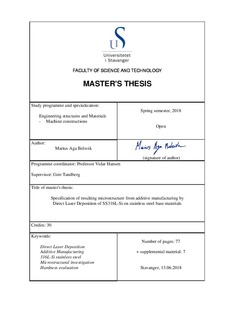| dc.contributor.advisor | Vidar, Hansen | |
| dc.contributor.author | Belsvik, Marius Aga | |
| dc.date.accessioned | 2018-09-11T08:59:04Z | |
| dc.date.available | 2018-09-11T08:59:04Z | |
| dc.date.issued | 2018-06 | |
| dc.identifier.uri | http://hdl.handle.net/11250/2561929 | |
| dc.description | Master's thesis in Mechanical engineering | nb_NO |
| dc.description.abstract | The purpose of this study was to investigate the macro- and microstructural constitution of Direct Laser Deposited (DLD) SS316L-Si on stainless steel base materials. The characterisation of the deposited material was carried out using light optical microscopy (LOM), scanning electron microscopy (SEM), energy dispersive X-ray spectroscopy (EDS), electron backscattered diffraction (EBSD), transmission- and scanning transmission electron microscopy (TEM and STEM) together with Vickers hardness measurements. The DLD process produced a crack-free, almost fully dense (porosity >99.5%) metallic part. The investigation revealed a duplex microstructure containing a primary austenitic matrix with secondary δ-ferrite interdendritic and along sub-grain boundaries. The δ-ferrite has formed due to segregation of ferrite stabilizing alloying elements and has helped voiding the material from hot-cracking during the thermal cycles. The austenitic dendrites have formed preferentially along <001> direction generating a solidification texture and large columnar grains along the thermal gradient being 5-10 times larger in longitudinal- than latitudinal direction. A microstructural variation exists throughout the samples with cellular- and columnar dendritic structures depending on solidification rate, with a localized heat-affect zone for each layer. While the process has formed a solid metallurgical bond to the base material in the case where the cleaning procedure was followed thoroughly, with a small heat-affect zone in the base material. Hardness values was found to be almost uniform in parallel- and normal to build directions, ~170HV. The elevated hardness compared to conventional manufactured SS316L is due to silicate nano-inclusions that generate large concentrations of dislocations and the uniform distribution of δ-ferrite facilitating the dislocation pile-ups. The investigation has also reveal defects such as entrapped gas which has created spherical pores, inter-track porosity along laser travel direction and segregation of alloying elements. Various solutions to improve the defects has been discussed so the study may serve as a guide to improve the process parameters. | nb_NO |
| dc.language.iso | eng | nb_NO |
| dc.publisher | University of Stavanger, Norway | nb_NO |
| dc.relation.ispartofseries | Masteroppgave/UIS-TN-IMBM/2018; | |
| dc.rights | Navngivelse-DelPåSammeVilkår 4.0 Internasjonal | * |
| dc.rights.uri | http://creativecommons.org/licenses/by-sa/4.0/deed.no | * |
| dc.subject | maskinteknikk | nb_NO |
| dc.subject | direct laser deposition | nb_NO |
| dc.subject | additive manufacturing | nb_NO |
| dc.subject | 116L - Si stainless steel | nb_NO |
| dc.subject | microstructural investigation | nb_NO |
| dc.title | Specification of resulting microstructure from additive manufacturing by Direct Laser Deposition of SS316L-Si on stainless steel base materials | nb_NO |
| dc.type | Master thesis | nb_NO |
| dc.subject.nsi | VDP::Teknologi: 500::Maskinfag: 570::Maskinkonstruksjon og materialteknologi: 571 | nb_NO |

